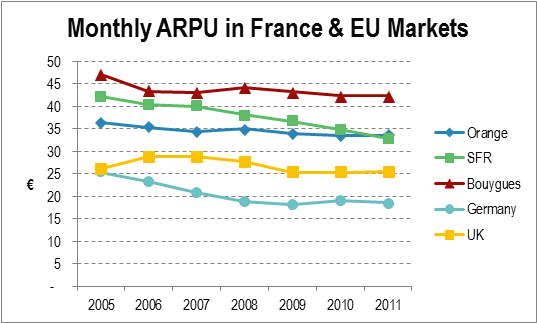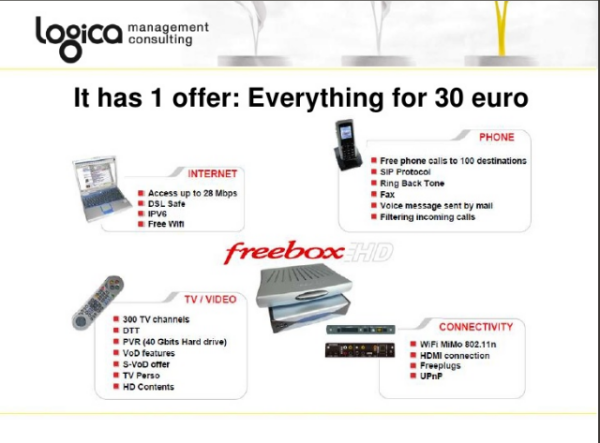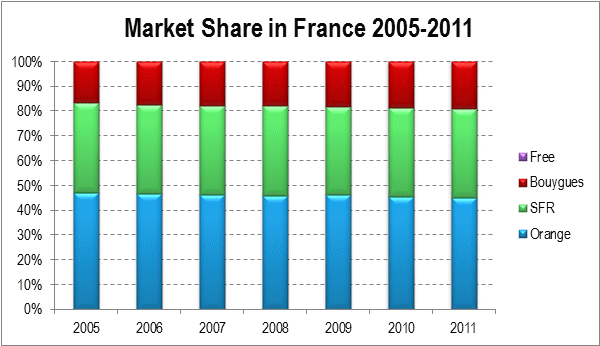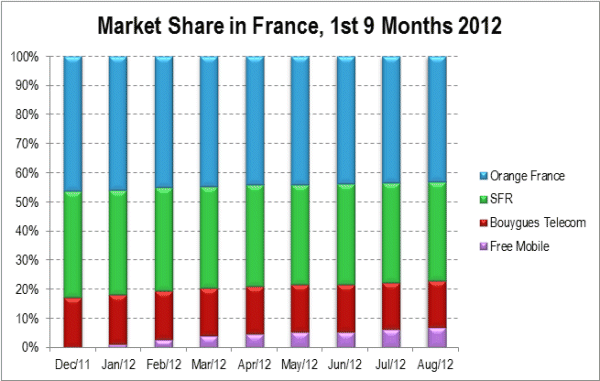|
Summary: Free.fr’s entry to the French mobile market has achieved extraordinarily rapid market share gains and resulted in comprehensive disruption. An analysis of its technology, tactics, and business model, and a high-level assessment of the applicability of its approach to other markets. (February 2013, Executive Briefing Service Dealing with Disruption Stream). |
|
Below is an extract from this 25 page Telco 2.0 Briefing Report that can be downloaded in full in PDF format by members of the Telco 2.0 Executive Briefing service and Dealing with Disruption Stream here. We'll be publishing more on Digital Commerce in in 2013 and it will be a key theme at our Executive Brainstorms in Silicon Valley (March 2013), and Europe (London, June 2013). Non-members can subscribe here and for this and other enquiries, please email / call +44 (0) 207 247 5003.
A major theme in our work on mobile operator strategy recently has been the potential for disruption on price. In the European Mobile: The Future’s not Bright, it’s Brutal report, we forecast a substantial decline in voice and messaging revenues across Europe, and identified a group of relatively high-priced markets in challenging Southern European economies that were especially at risk from a competitive shock.
In the subsequent Europe’s Brutal Future: Vodafone & Telefonica hit hard we responded to the announcement of grim results at Telefonica and Vodafone’s southern European units. And in Sprint-Softbank: how it will disrupt the US market, we looked at the state of the US mobile market as Sprint is acquired by Softbank and investment starts to flow into T-Mobile USA.
Further, since we published the Sprint-Softbank note, 3UK has announced that it is planning to launch LTE later this year, as soon as the disbursed 1800MHz spectrum from the EverythingEverywhere merger becomes available. The service will be launched at a zero price premium to their 3G tariffs. This contrasts with EE’s initial pricing, which tried to define 4G as a premium product, and suggests that whatever pricing power their go-it-alone LTE deployment gave them will be very short-lived.
So it appears that structural pressures, like macroeconomic problems, the concentration of unemployment among the young (an early-adopter demographic), and the increasing availability and adoption of alternatives (Skype, BBM, Whatsapp, etc), are bearing down on prices in many markets. One outcome is that eventually operators will be forced to cut prices and therefore accept gradual reductions in their profit margins. Another outcome is more radical disruption through the entry of new players, which if successful can have a much higher impact on incumbent players.
In this note, we will look at the disruption of the French MNO market brought about by the entry of Free Mobile, which is both a case study of best practice and also one that illustrates some of the key constraints on disruption. We identify a new class of operator, the low-cost disruptor, empowered by software to go after incumbents’ margins, and look at the criteria for their success.
France, before Free’s entry to the market, was one of the less competitive and pricier mobile markets in Europe with three operators only, one of them being the part-nationalised incumbent France Telecom. Immediately before Free Mobile’s launch, Fitch Ratings estimated the price of a minute of mobile voice in France at €0.10, compared to €0.07 in the UK or Germany . In terms of monthly ARPU, we can see that the cheapest French operator (interestingly, the incumbent) has usually been around €15 a month dearer than the average German operator and about €10 a month dearer than the average British operator.

The regulator, ARCEP, was often characterised as being relatively weak, or else committed to a strategy of letting the operators have more margin in the hope of encouraging infrastructure development.
Politically, this isn’t quite accurate. Importantly, ARCEP wasn’t the only actor involved – the ministries and regional governments also had a substantial voice in policy, and the incumbent enjoyed special access to the top level of politics as a major state enterprise. (In fact, for part of the 2000s, the French minister of finance’s previous job was CEO of France Telecom.)
Although the European Union’s Information Society, Competition, and Internal Market directorates also influenced the regulatory environment, telecoms is one of the fields where responsibility is shared between the EU and national authorities, and France is a big enough power within the EU to largely shape its own policy. This typically expresses a preference for the development of large national champion companies, and for infrastructure development over either competition or consumer protection.
On the other hand, ARCEP was one of the first regulators to permit independent ISPs to use the incumbent’s civil works infrastructure, and the public sector was very active in investing in middle-mile dark fibre. The upshot of this was that France has a fixed ISP market that offers customers remarkable value – FTTH is more available, speeds are better, and voice pricing is better for comparable rates to those prevailing in the UK, which has a roughly comparable market structure.
A major driver of this was a disruptive entrant, Free.fr. Free has been intensively studied, but we will briefly recap some key points. Free’s flagship service offering is €29.99/mo for everything, that including their fastest Internet service, unlimited VoIP to many destinations, and a variety of IT services. Over time, the purity of this price point has been diluted, but it still exists for new subscribers. Free.fr has no marketing department in a classical sense, and their tech support is largely provided by a network of partners recruited from the subscriber base.
On the other hand, they have historically invested without compromise in technology. Not only does Free develop its own software, it developed a succession of very successful set-top boxes, and it even developed its own ADSL2+ equipment. Further, they were an early adopter of FTTH, benefiting from the regulated access to civil works and the public investment in middle-mile fibre. Free was one of the first ISPs to provide IPv6 to end users. The TVPerso service was a pioneering user-generated content platform that provided multicast live streaming years ahead of anyone else.

In mobile, however, the picture was rather different. Only three operators, and one of those being the main supplier of backhaul connectivity, resulted in relatively little competition and high ARPUs and margins in the international context. Market share, particularly, has been remarkably, almost suspiciously, stable over time, as the following chart demonstrates.

Source: STL
Until, of course, Free became a mobile operator, launching on the 10th January 2012.
Free Mobile’s product strategy could not have been simpler. It had two key points: price, and quantity. As with the fixed ISP product, the strategy was to offer big bundles at low prices, notably by unbundling the price of the mobile device from the service contract. The best deal was the bring-your-own-device option. (We also saw this with Softbank.)
Specifically, there were two options at launch. New subscribers could pay €20/mo for unlimited national calls and international calls to 40 countries, unlimited messaging, and 3GB/mo of Internet service. Existing subscribers to fixed service benefited from a discount to €16/mo. There was also an ultra-low cost plan, which offers 60 minutes of voice and 60 text messages for €2/mo with no contractual commitment and no phone, and overage set at €0.05/minute. This was free as an add-on to an existing fixed subscription. In general, Free Mobile customers remain free to switch provider on a rolling basis, rather than being tied in for the duration of the contract.
As Diffraction Analysis’ Benoit Felten points out, the company traditionally targeted two groups, technology-focused early adopters, and price-driven discount chasers . As a result, as well as bringing your own phone, you could also have the latest iPhone, unlocked, if you were willing to pay an additional €19.99/mo.
Bigger bundles at lower prices suggest a material cost advantage over other players. This is the essence of a Telco 2.0 Happy Piper: engineer operations for efficient bulk IP traffic delivery and ensure prices remain below those offered by competitors and, at the same time, deliver acceptable margins.
Free rapidly gained subscribers from the other MNOs and from the MVNO sector, and probably also from new adopters on the ultra-low cost tariffs. By the end of March, it had gained 2.6 million subscribers, 4% of the market, and declared a target of between 15 and 25 per cent market share. By mid-year, its market share had passed 5%, and by the end of Q3 2012 (the last published results), 6.4%, or 4.4 million subscribers with a run-rate of 270,000 net-adds per month.

Source: WCIS, STL
This resulted in a price shock across the entire market and a rapid rise in indicators of competition generally. It also resulted in a surge of additional subscriber growth.
To read the note in full, including the following sections detailing support for the analysis...
...and the following figures...